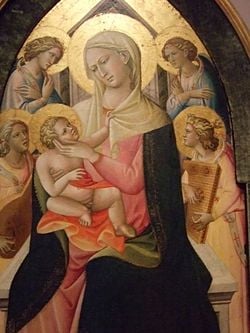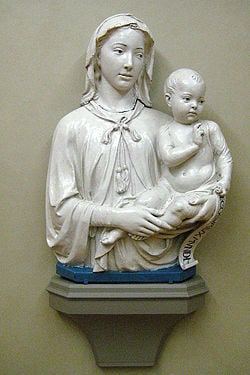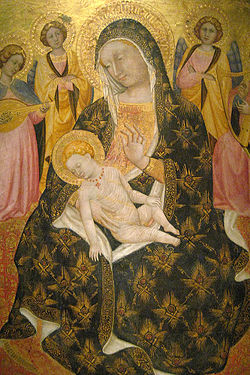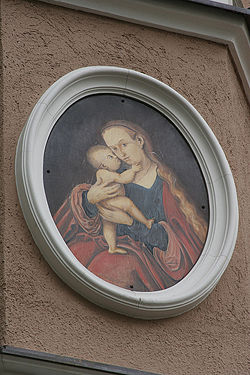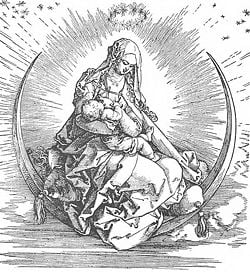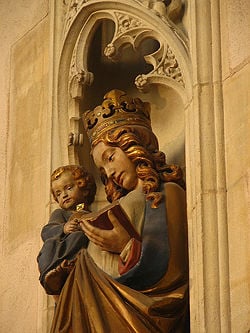Madonna (art)
Images of the Madonna and Madonna and Child are among the central icons of Christianity, representing the Madonna or Mary, mother of Jesus, by herself or, rather more often, with her son Jesus. The formula Theotokos ("Mother of God") was adopted officially by the Christian Church at the Council of Ephesus in 431, after some initial resistance and controversy, beginning the period of more than one thousand years when images of Mary were central to Western art.
Madonna, if used to describe a work of art, rather than a single figure in one, refers to a portrait-style image of Mary, but the term is often loosely used for those of the "Madonna and Child" as well. The presence of angels does not affect the use of the term. An altarpiece of the "Madonna and Saints," or a narrative painting of a scene from the Life of the Virgin usually will have a specific title for that scene, such as the Annunciation to Mary. Most often, and nearly always if holding Jesus, Mary is seated, and shown at half-length or full-length. In various types of images she is shown alone, at full-length and standing.
The Madonna image remains a robust synthesis of religion and art and helps many Christian faithful focus prayers and other devotional practices. It is also used as an opportunity for artists to express, simultaneously, their creativity and their religious devotion.
Etymology
Madonna is a medieval Italian term for a noble or otherwise important woman, and has long been used commonly in reference to images of the Virgin Mary, the mother of Jesus. The word has also been adopted by the English and other European languages. "Madonna," translates as "My Lady." While stressing the personal, and at the same time reverent relationship between the Virgin and the devout Christian who addresses her in prayer, it is comparable to the French, "Notre Dame," or "Our Lady." These names signal both the increased importance of the Cult of the Virgin and the prominence of art in service to devotion to the Virgin Mary during the late medieval period. During the thirteenth century, especially, with the increasing influence of chivalry and aristocratic culture on poetry, song and the visual arts, the Madonna is represented as the Queen of Heaven, often enthroned. Strictly speaking, the term "Madonna" should be used exclusively for Italian works of sacred art, but this is often not followed. Images of Mary created by any artist, where Mary is depicted alone or with the infant Christ and possibly some angels, may all be loosely referred to as just a "Madonna."
Overview
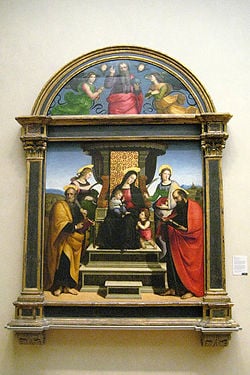
Perhaps the reason that the Madonna is often depicted with the infant Jesus is because the theme of motherly love, in its purest form, is quite easy to relate to. Few are too ignorant to understand it or too wise to be beyond it.[1] Several different ways of grouping Madonnas have developed, owing to the large number of examples in circulation. They can be organized based on the time period of the work, the physical structure of the paintings, or the relationship and attitude towards the child that is being represented. When looking at the physical structure of the painting, the bulk of work can be separated into five classes:
- The Portrait Madonna, the figures in half-length against an indefinite background.
- The Madonna Enthroned, where the setting is some sort of a throne or dais.
- The Madonna in the Sky or the "Madonna in Gloria," where the figures are set in the heavens, as represented by a glory of light, by clouds, by a company of cherubs, or by simple elevation above the earth's surface.
- The Pastoral Madonna, with a landscape background.
- The Madonna in a Home Environment, where the setting is an interior.[1]
When looking at the relationship between Mary and the child, the works can be divided into groups according to the following three themes:
- The Madonna of Love (The Mater Amabilis), in which the relation is purely maternal. The emphasis is upon a mother's natural affection as displayed towards her child.
- The Madonna in Adoration (The Madre Pia), in which the mother's attitude is one of humility, contemplating her child with awe.
- The Madonna as Witness, in which the Mother is preeminently the Christ-bearer, wearing the honors of her proud position as witness to her son's great destiny.[1]
The Madonna has an exceptionally long history, especially in Europe.
History
There was a great expansion of the cult of Mary after the Council of Ephesus in 431, when her status as Theotokos was confirmed; this had been a subject of some controversy until then, though mainly for reasons to do with arguments over the nature of Christ. In mosaics in Santa Maria Maggiore in Rome, dating from 432-440, just after the council, she is not yet shown with a halo, and she is also not shown in Nativity scenes at this date, though she is included in the Adoration of the Magi.
The earliest representation of the Madonna and Child may be the wall painting in the Catacomb of Priscilla, Rome, in which the seated Madonna suckles the Child, who turns his head to gaze at the spectator.[2] By the mid-sixth century, the familiar image of the Virgin enthroned carrying the infant Christ was established, as in the example from the only group of icons surviving from this period, at Saint Catherine's Monastery, Mount Sinai. This type of depiction, with subtly changing differences of emphasis, has remained the mainstay of depictions of Mary to the present day. The image at Mount Sinai succeeds in combining two aspects of Mary described in the Magnificat, her humility and her exaltation above other humans.
It was in the Eastern Empire, one of the areas which later became part of the domain of the Eastern Orthodox Church when it separated from the Catholic Church in the eleventh century that the earliest pattern of consistent representations of Mother and Child were developed, developing into the icons that are now well known throughout the Orthodox Church.
During the Byzantine Empire there were two periods of iconoclasm, in the eighth and ninth centuries, when the Byzantine leaders ordered the removal of holy images, including images of Mary, concerned that people would focus their worship on the images themselves, rather than on the holy figures they represented. Later leaders had more accepting attitudes, and holy images, including Madonnas, began to flourish once again. Some Eastern examples show the Madonna enthroned, even wearing the closed Byzantine pearl-encrusted crown with pendants, with the Christ Child on her lap.
Madonnas in the West, followed the Eastern Byzantine models closely the Early Middle Ages, but with the increased importance of the cult of the Virgin in the twelfth and thirteenth centuries, a wide variety of types developed to satisfy a flood of more intensely personal forms of piety. In the usual Gothic and Renaissance formulas, the Virgin Mary sits with the Infant Jesus on her lap, or enfolded in her arms. In earlier representations the Virgin is enthroned, and the Child may be fully aware, raising his hand to offer blessing. In a fifteenth century Italian variation, a baby John the Baptist looks on.
The Madonna continues to be a popular subject in modern art.
Byzantine influence on the West
The Italian tradition, central to the history of Madonnas in the west was strongly influenced by the Byzantine icons, especially those created in Constantinople (Istanbul), the capital of the longest, enduring medieval civilization whose icons were celebrated for their miraculous properties.
Byzantium (324-1453) saw itself as the center of the Christian empire, and had colonies of Italians living among its citizens, participating in Crusades at the borders of its land, and ultimately, plundering its churches, [[palace]s and monasteries of many of its treasures. Later in the Middle Ages, the Cretan school was the main source of icons for the West, and the artists there could adapt their style to Western iconography when required.
While theft is one way that Byzantine images made their way West to Italy, the relationship between Byzantine icons and Italian images of the Madonna is far more rich and complicated. Byzantine art played a long, critical role in Western Europe, especially when Byzantine territories included parts of Eastern Europe, Greece and much of Italy itself. Byzantine manuscripts, ivories, gold, silver and luxurious textiles were distributed throughout the West. In Byzantium, Mary's usual title was the Theotokos or Mother of God, rather than the Virgin Mary and it was believed that salvation was delivered to the faithful at the moment of God's incarnation. That theological concept takes pictorial form in the image of Mary holding her infant son.
However, what is most relevant to the Byzantine heritage of the Madonna is twofold. First, the earliest surviving independent images of the Virgin Mary are found in Rome, the center of Christianity in the medieval West. One is a valued possession of Santa Maria in Trastevere, one of the many Roman churches dedicated to the Virgin Mary. Another, a splintered, repainted ghost of its former self, is venerated at the Pantheon, that great architectural wonder of the Ancient Roman Empire, that was rededicated to Mary as an expression of the Church's triumph. Both evoke Byzantine tradition in terms of their medium, that is, the technique and materials of the paintings, in that they were originally painted in tempera (egg yolk and ground pigments) on wooden panels. In this respect, they share the Ancient Roman heritage of Byzantine icons. Second, they share subject matter. Each image stresses the maternal role that Mary plays, representing her in relationship to her infant son. It is difficult to gauge the dates of these earlier images, however, they seem to be primarily works of the seventh and eighth centuries.
Expanding beyond Rome
It was not until the revival of monumental panel painting in Italy during the twelfth and thirteenth centuries, that the image of the Madonna gained prominence outside of Rome, especially throughout Tuscany. While members of the mendicant orders of the Franciscan and Dominican Orders are some of the first to commission panels representing this subject matter, such works quickly became popular in monasteries, parish churches, and homes. Some images of the Madonna were paid for by lay organizations called confraternities, who met to sing praises of the Virgin in chapels found within the newly reconstructed, spacious churches that were sometimes dedicated to her. Paying for such a work might also be seen as a form of devotion. Its expense registers in the use of thin sheets of real gold leaf in all parts of the panel that are not covered with paint, a visual analogue not only to the costly sheaths that medieval goldsmiths used to decorate altars, but also a means of surrounding the image of the Madonna with illumination from oil lamps and candles. Even more precious is the bright blue mantle colored with lapis lazuli, a stone imported from Afghanistan.
While the focus of these works stressed the depiction of the Madonna in panel painting, it should be noted that her image also appears in mural decoration, whether mosaics or fresco painting on the exteriors and interior of sacred buildings. She is found high above the apse, or east end of the church where the liturgy is celebrated in the West. She is also found in sculpted form, whether small ivories for private devotion, or large sculptural reliefs and free-standing sculpture. As a participant in sacred drama, her image inspires one of the most important fresco cycles in all of Italian painting: Giotto's narrative cycle in the Arena Chapel, next to the Scrovegni family's palace in Padua. This program dates to the first decade of the fourteenth century.
Italian artists of the fifteenth century onward are indebted to traditions established in the thirteenth and fourteenth centuries in their representation of the Madonna.
Renaissance
While the fifteenth and sixteenth centuries were a time when Italian painters expanded their repertoire to include historical events, independent portraits, and mythological subject matter, Christianity retained a strong hold on their careers. Most works of art from this era are sacred. While the range of religious subject matter included subjects from the Old Testament and images of saints whose cults date after the codification of the Bible, the Madonna remained a dominant subject in the iconography of the Renaissance.
Some the most famous Italian painters to turn to this subject are da Vinci, Michelangelo, Raphael, Giorgione, Giovanni Bellini, and Titian, in the sixteenth century. They developed on the foundations of fifteenth century Marian images by Fra Angelico, Fra Filippo Lippi, Mantegna and Piero della Francesca in particular, among countless others. The subject was equally popular in Early Netherlandish painting and that of the rest of Northern Europe.
The subject retaining the greatest power on all of these men remained the maternal bond, even though other subjects, especially the Annunciation, and later the Immaculate Conception, led to a greater number of paintings that represented Mary alone, without her son. As a commemorative image, the Pietà, where Mary hold the lifeless body of the crucified Jesus, became an important subject, newly freed from its former role in narrative cycles, in part, an outgrowth of popular devotional statues in Northern Europe. Traditionally, Mary is depicted expressing compassion, grief, and love, usually in highly charged, emotional works of art even though the most famous, early work by Michelangelo stifles signs of mourning. The tenderness an ordinary mother might feel towards her beloved child is captured, evoking the moment when she first held her infant son Christ. The spectator, after all, is meant to sympathize, to share in the despair of the mother who holds the body of her crucified son.
Madonna in controversy
The Madonna has not always been accepted as a form of mainstream art, and continues to face challenges in modern times. Because so little is known about the historical woman of Mary, and nothing is known about her appearance, early Christian opponents of religious art found that any image of "Mary" bore no relation to the person in reality, and resembled instead a pagan idol. A writer at the court of Charlemagne attacked the adoration of imagery by pointing to the problem of identifying a statue of a woman with a child in her lap. It could be Venus and Cupid, Alcmeme and Hercules, or the Virgin Mary and baby Jesus. Which brought to light the conflict: To venerate the image as sacred and Christian, or to treat it as an idol and destroy it.[3]
In 1605-1606, Caravaggio painted Death of the Virgin, and although it was rejected for its lack of decorum, it was rumored that Caravaggio based his figure of Mary on a prostitute, who may have been the artist's lover.[3]
Even more recently, Chris Ofili's 1996 collage, The Holy Virgin Mary, caused an enormous stir in New York City, where it was displayed at the Brooklyn Art Museum. The collage featured a representation of the Virgin Mary (which looked quite a lot like Ingrid Bergman) covered in elephant dung. While the intention of the painting was to be shocking, it was in fact so inflammatory that then-mayor Rudy Giuliani threatened to cut funding to the Brooklyn Art Museum unless the work was taken down. Giuliani said, "The idea of having so-called works of art in which people are throwing elephant dung at a picture of the Virgin Mary is sick." And while most art critics disagreed with the New York City Mayor, the museum eventually yielded.[3]
Beyond Italy
Some of representations of Mary that were not created by Italians, but are nevertheless referred to as Madonnas include:
- Golden Madonna of Essen: The earliest large-scale sculptural example in Western Europe; made for an Ottonian abbess and a precedent for the polychrome wooden processional sculptures of Romanesque France, a type known as Throne of Wisdom
- Madonna and Child: Also known as the Stroclet Madonna or Stroganoff Madonna, a painting by Duccio di Buoninsegna, from around the year 1300
- The Black Madonna of Częstochowa: Czarna Madonna or Matka Boska Częstochowska in Polish, icon, which was, according to legend, painted by Saint Luke the Evangelist on a cypress table top from the house of the Holy Family
- Madonna and Child with Flowers: Otherwise known as the Benois Madonna, possibly one of two works begun by the artist, as documented in October 1478
- Madonna of the Steps: A relief by Michelangelo
- The Madonna of Port Lligat: The name of two paintings by Salvador Dalí created in 1949 and 1950
- The Fallen Madonna: A fictitious painting from the series, Allo! Allo!
Conclusion
Mary, mother of Jesus, has been an important figure throughout the history of Christianity. From early in Christian history, artists have created images of Mary, or Madonnas, which have been used in churches as a focus for devotional practices by many Christians. These Madonnas, whether rendered as icons, mosaic, painting, sculpture or other forms have been the source of strength, comfort and inspiration to Christians through the ages. In addition to the Madonnas found in churches, shrines, grottos and other public areas, many faithful individuals also have smaller icons, sculptures, pendants and other Madonnas that they use in their personal devotional practices.
See also
- Mary (mother of Jesus)
- Icon
- Assumption of Mary
- Christian Art
- Art in Roman Catholicism
Notes
- ↑ 1.0 1.1 1.2 Estelle M. Hurll, The Madonna in Art, Project Gutenberg Retrieved September 28, 2008.
- ↑ Victor Lasareff, "Studies in the Iconography of the Virgin" The Art Bulletin 20 (1): 27.
- ↑ 3.0 3.1 3.2 Michael Davis, October 8, 1999,Dung-Covered Madonna Sparks Controversy, College Street Journal 13 (6). Retrieved September 28, 2008.
ReferencesISBN links support NWE through referral fees
- Davis, Michael, October 8, 1999, Dung-Covered Madonna Sparks Controversy, College Street Journal 13 (6), Mount Holyoke College, Retrieved September 28, 2008
- Dobell, Steve. Mary: The Madonna in Art. London: Southwater, 2005. ISBN 9781844761661.
- Hurll, Estelle M. The Madonna in Art. Boston: LC Page and Co., 1898; Detroit: Gale Research Co. ISBN 9780810340831
- Lasareff, Victor, "Studies in the Iconography of the Virgin," The Art Bulletin 20 (1): 27.
- Silvestrini, Achille, Fabrizio Mancinelli, Samuele Olivieri, and Ornella Casazza. The Life of the Madonna in Art. Boston: Daughters of St. Paul, 1985. ISBN 9780819844408.
External links
All links retrieved March 27, 2025.
- Metropolitan Museum: The cult of the Virgin Mary in the Middle Ages
- Virgin Mary at Olga's Gallery
- The Madonna in Art, available for free via Project Gutenberg by Estelle M. Hurll (First printed 1897)
Credits
New World Encyclopedia writers and editors rewrote and completed the Wikipedia article in accordance with New World Encyclopedia standards. This article abides by terms of the Creative Commons CC-by-sa 3.0 License (CC-by-sa), which may be used and disseminated with proper attribution. Credit is due under the terms of this license that can reference both the New World Encyclopedia contributors and the selfless volunteer contributors of the Wikimedia Foundation. To cite this article click here for a list of acceptable citing formats.The history of earlier contributions by wikipedians is accessible to researchers here:
The history of this article since it was imported to New World Encyclopedia:
Note: Some restrictions may apply to use of individual images which are separately licensed.
